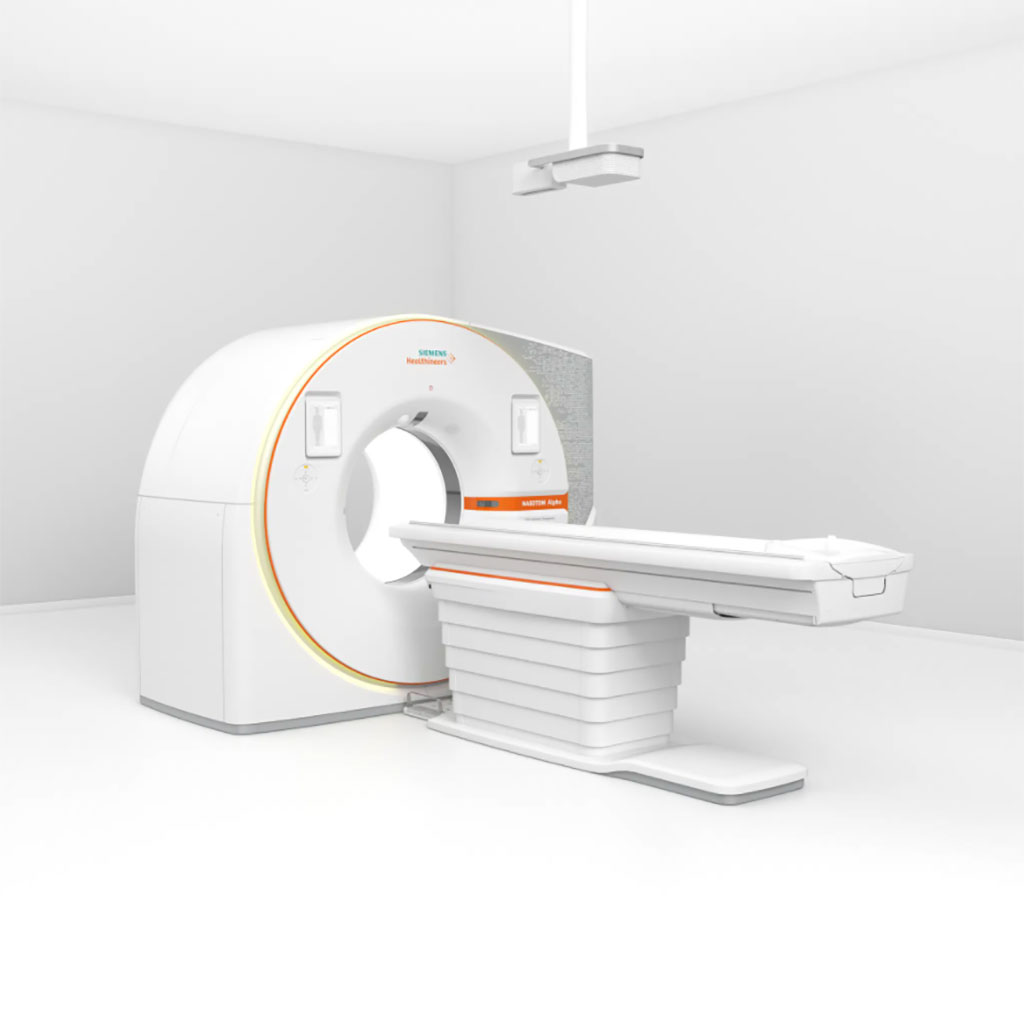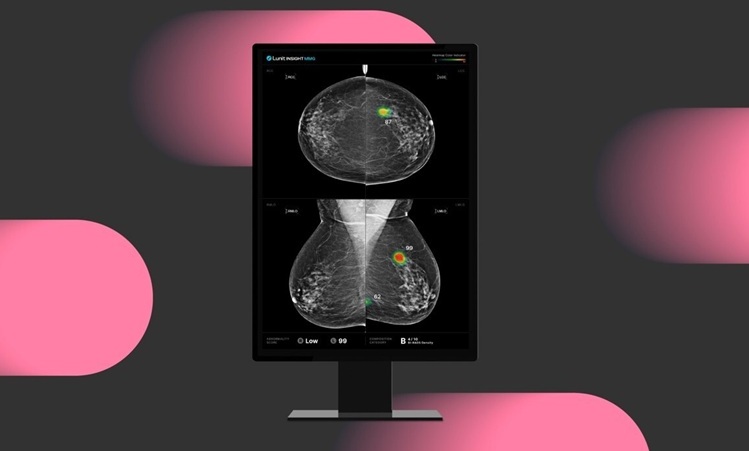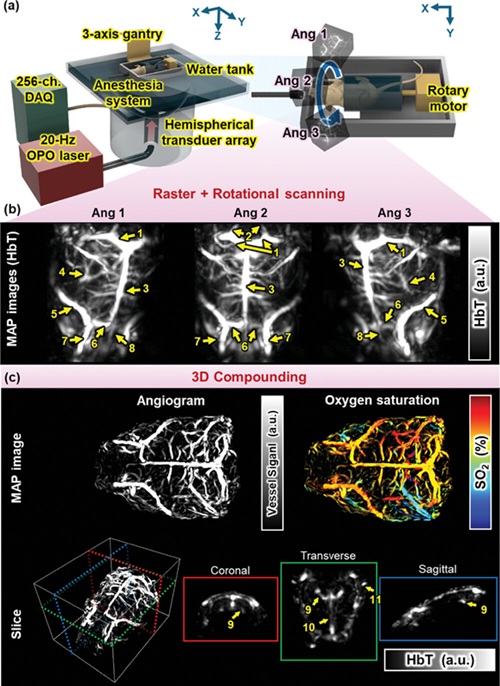Siemens Unveils World’s First Photon-Counting CT at RSNA 2021
|
By MedImaging International staff writers Posted on 29 Nov 2021 |

Siemens Healthineers (Erlangen, Germany) unveiled the NAEOTOM Alpha, the world’s first photon-counting CT scanner, at RSNA 2021.
The system is cleared for clinical use in the U.S. and Europe. Conventional CT imaging has reached its technical limitations: Resolution can only be improved by small margins and dose cannot be reduced significantly: Photon-counting technology enables drastic improvements. These improvements include an increase in resolution and a reduction in radiation dose by up to 45% for ultra-high resolution (UHR) scans compared with conventional CT detectors with a UHR comb filer. This would be impossible with conventional detectors. Photon-counting scans contain more useable data, due to the fact that photon-counting technology directly detects each X-ray photon and its energy level instead of first converting it into visible light as with conventional CT imaging.
These aspects combined open up new capabilities, such as scanning a patient’s lung at a high scan speed and obtaining high-resolution images with inherent spectral information—without the patient having to hold their breath. This spectral information also helps to identify materials inside the body that can even be removed from the image should they obstruct an area of interest. This helps physicians to assess issues quickly and offers the possibility to begin treatment early. Through the reduction in radiation dose, regular examinations such as lung cancer screenings using CT imaging can become routinely available for larger patient populations. And the high resolution reveals even small structures, taking clinical decision-making to a new level of confidence. The technical complexity of photon-counting CT imaging does not mean increased complexity for the user, thanks to myExam Companion from Siemens.
The clinical fields of cardiac imaging, oncology, and pulmonology all have their own unique demands of medical images. In cardiac imaging, it is capturing the heart while moving, which therefore requires speed. The NAEOTOM Alpha delivers speed thanks to its Dual Source design and benefits from spectral information and high resolution for removing obstructions caused by calcifications. This enables diagnostic assessment and allows more patients to benefit from CT imaging - even those with a high calcium burden.
The high precision offered by the NAEOTOM Alpha is also highly beneficial in oncology, where reliable and consistent evaluation of disease progress is the most important factor. Therefore, clinical images need to be as conclusive and consistent as possible to make the right decisions. In pulmonology, images need to contain all meaningful answers in as few scans as possible to avoid treatment delays and potentially severe consequences for patients. These needs are met and often exceeded by the NAEOTOM Alpha’s features. Its clinical images inherently carry more information than ever possible before for precise diagnosis, follow-up, and treatment.
The implications of this innovation from Siemens are far-reaching for patients and physicians, and may profoundly change the way that CT imaging is performed: It adds clinical value for fast, reliable diagnoses by the physician by improving image quality, potentially leading to less uncertainty for physicians and patients. The new technology helps in almost every clinical field, but especially when fine structures have to be evaluated.
“More than 15 years ago, work on photon-counting CT and this clinical vision started at Siemens Healthineers. We always believed in the tremendous clinical value and relentlessly worked on it together with our partners,” said Philipp Fischer, Head of Computed Tomography at Siemens Healthineers. “Today, with the introduction of the NAEOTOM Alpha, we are taking a huge step in furthering patient care in a wide range of clinical domains by effectively showing things impossible to see with conventional CT scans. This required a radical rethinking of practically every technological aspect of computed tomography.”
Related Links:
Siemens Healthineers
Latest RSNA 2021 News
- Samsung Showcases Its Premium Diagnostic Imaging Solutions in Ultrasound, DR and Mobile CT at RSNA 2021
- Konica Minolta Introduces New High Performance Mobile X-Ray and High-Definition FPD at RSNA 2021
- Hologic Showcases Extensive Portfolio of Breast and Skeletal Health Products at RSNA 2021
- Visage Imaging Introduces Easy to Create Video Radiology Reports for Improved Patient Engagement at RSNA 2021
- Agfa Healthcare Launches its New Valory Digital Radiography (DR) Room at RSNA 2021
- GE Healthcare Introduces Industry’s First Modular, Scalable Computed Tomography (CT) Platform at RSNA 2021
- Fujifilm Launches New High Performance Velocity MRI System at RSNA 2021
- Bracco Celebrates Personalized and Precision Medicine Innovations at RSNA 2021
- PaxeraHealth Launches Ark Platform to Make AI More Accessible and Affordable at RSNA 2021
- IBM Watson Health Presents New Portfolio of Solutions Designed for Enterprise Imaging, Radiology and Cardiology at RSNA 2021
- Varex Exhibits Highly Innovative Photon Counting X-Ray Detectors at RSNA 2021
- Carestream Showcases Enhanced DR Room Imaging and AI Innovations at RSNA 2021
- Guerbet Showcases Comprehensive Range of Imaging Products, Solutions, and Services for Diagnostic Imaging at RSNA 2021
- Sectra Highlights Brilliant Radiology Workflows at RSNA 2021
- Barco Presents Solutions for Mammography, Remote Radiology Reading, Interventional Radiology and QA at RSNA 2021
- Canon Unveils New Vantage Fortian Advanced Productivity, Open Bore 1.5T MRI System at RSNA 2021
Channels
Radiography
view channel
Higher Chest X-Ray Usage Catches Lung Cancer Earlier and Improves Survival
Lung cancer continues to be the leading cause of cancer-related deaths worldwide. While advanced technologies like CT scanners play a crucial role in detecting lung cancer, more accessible and affordable... Read more
AI-Powered Mammograms Predict Cardiovascular Risk
The U.S. Centers for Disease Control and Prevention recommends that women in middle age and older undergo a mammogram, which is an X-ray of the breast, every one or two years to screen for breast cancer.... Read moreMRI
view channel
Ultra-Powerful MRI Scans Enable Life-Changing Surgery in Treatment-Resistant Epileptic Patients
Approximately 360,000 individuals in the UK suffer from focal epilepsy, a condition in which seizures spread from one part of the brain. Around a third of these patients experience persistent seizures... Read more
AI-Powered MRI Technology Improves Parkinson’s Diagnoses
Current research shows that the accuracy of diagnosing Parkinson’s disease typically ranges from 55% to 78% within the first five years of assessment. This is partly due to the similarities shared by Parkinson’s... Read more
Biparametric MRI Combined with AI Enhances Detection of Clinically Significant Prostate Cancer
Artificial intelligence (AI) technologies are transforming the way medical images are analyzed, offering unprecedented capabilities in quantitatively extracting features that go beyond traditional visual... Read more
First-Of-Its-Kind AI-Driven Brain Imaging Platform to Better Guide Stroke Treatment Options
Each year, approximately 800,000 people in the U.S. experience strokes, with marginalized and minoritized groups being disproportionately affected. Strokes vary in terms of size and location within the... Read moreUltrasound
view channel
Tiny Magnetic Robot Takes 3D Scans from Deep Within Body
Colorectal cancer ranks as one of the leading causes of cancer-related mortality worldwide. However, when detected early, it is highly treatable. Now, a new minimally invasive technique could significantly... Read more
High Resolution Ultrasound Speeds Up Prostate Cancer Diagnosis
Each year, approximately one million prostate cancer biopsies are conducted across Europe, with similar numbers in the USA and around 100,000 in Canada. Most of these biopsies are performed using MRI images... Read more
World's First Wireless, Handheld, Whole-Body Ultrasound with Single PZT Transducer Makes Imaging More Accessible
Ultrasound devices play a vital role in the medical field, routinely used to examine the body's internal tissues and structures. While advancements have steadily improved ultrasound image quality and processing... Read moreNuclear Medicine
view channel
Novel PET Imaging Approach Offers Never-Before-Seen View of Neuroinflammation
COX-2, an enzyme that plays a key role in brain inflammation, can be significantly upregulated by inflammatory stimuli and neuroexcitation. Researchers suggest that COX-2 density in the brain could serve... Read more
Novel Radiotracer Identifies Biomarker for Triple-Negative Breast Cancer
Triple-negative breast cancer (TNBC), which represents 15-20% of all breast cancer cases, is one of the most aggressive subtypes, with a five-year survival rate of about 40%. Due to its significant heterogeneity... Read moreGeneral/Advanced Imaging
view channel
AI Model Significantly Enhances Low-Dose CT Capabilities
Lung cancer remains one of the most challenging diseases, making early diagnosis vital for effective treatment. Fortunately, advancements in artificial intelligence (AI) are revolutionizing lung cancer... Read more
Ultra-Low Dose CT Aids Pneumonia Diagnosis in Immunocompromised Patients
Lung infections can be life-threatening for patients with weakened immune systems, making timely diagnosis crucial. While CT scans are considered the gold standard for detecting pneumonia, repeated scans... Read moreImaging IT
view channel
New Google Cloud Medical Imaging Suite Makes Imaging Healthcare Data More Accessible
Medical imaging is a critical tool used to diagnose patients, and there are billions of medical images scanned globally each year. Imaging data accounts for about 90% of all healthcare data1 and, until... Read more
Global AI in Medical Diagnostics Market to Be Driven by Demand for Image Recognition in Radiology
The global artificial intelligence (AI) in medical diagnostics market is expanding with early disease detection being one of its key applications and image recognition becoming a compelling consumer proposition... Read moreIndustry News
view channel
GE HealthCare and NVIDIA Collaboration to Reimagine Diagnostic Imaging
GE HealthCare (Chicago, IL, USA) has entered into a collaboration with NVIDIA (Santa Clara, CA, USA), expanding the existing relationship between the two companies to focus on pioneering innovation in... Read more
Patient-Specific 3D-Printed Phantoms Transform CT Imaging
New research has highlighted how anatomically precise, patient-specific 3D-printed phantoms are proving to be scalable, cost-effective, and efficient tools in the development of new CT scan algorithms... Read more
Siemens and Sectra Collaborate on Enhancing Radiology Workflows
Siemens Healthineers (Forchheim, Germany) and Sectra (Linköping, Sweden) have entered into a collaboration aimed at enhancing radiologists' diagnostic capabilities and, in turn, improving patient care... Read more




















